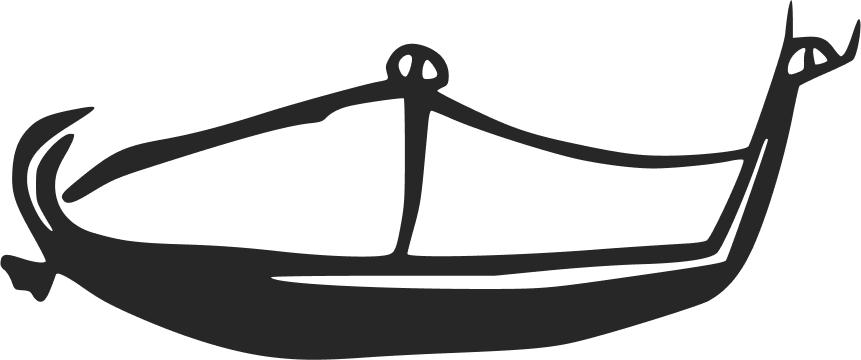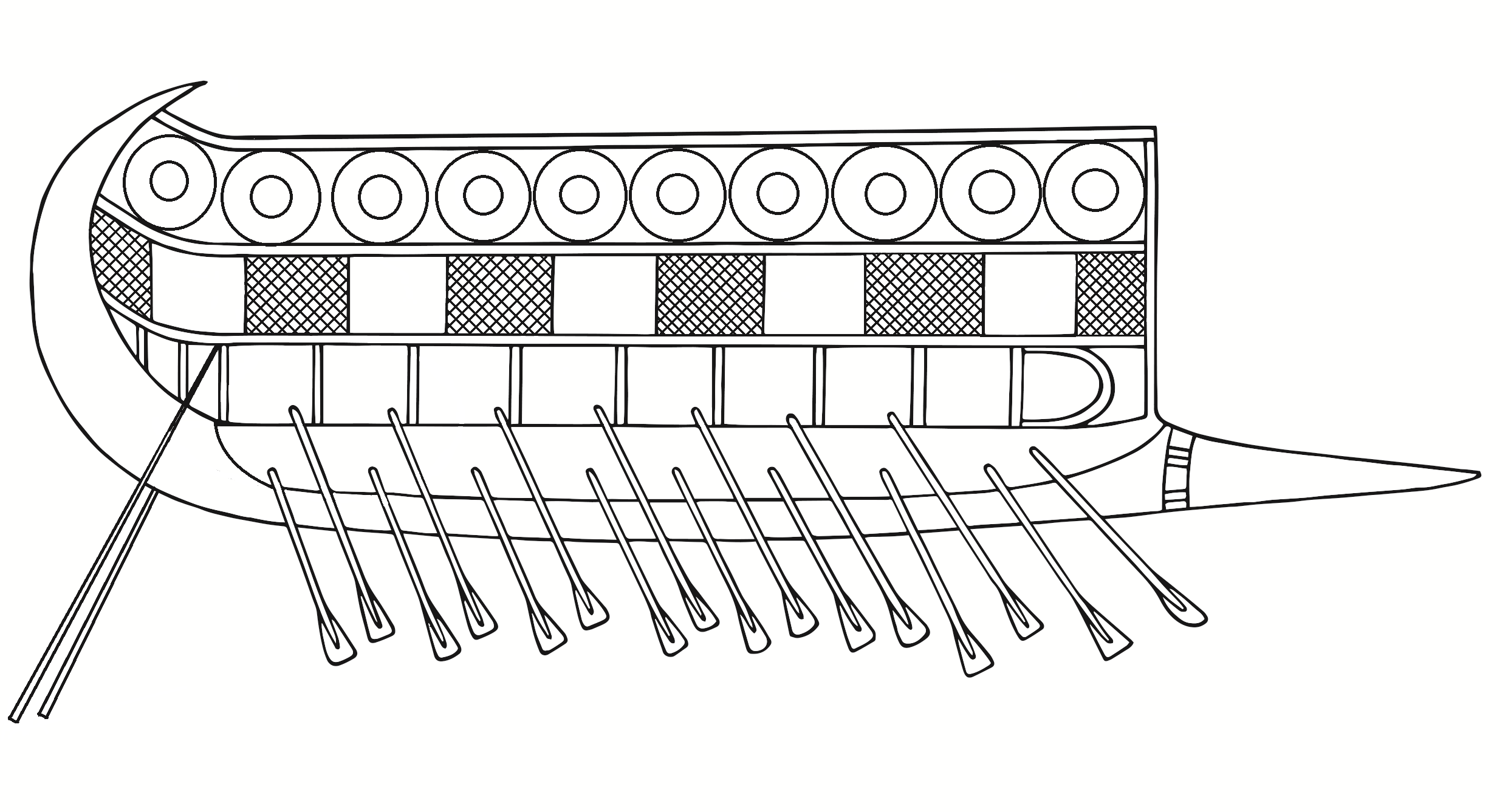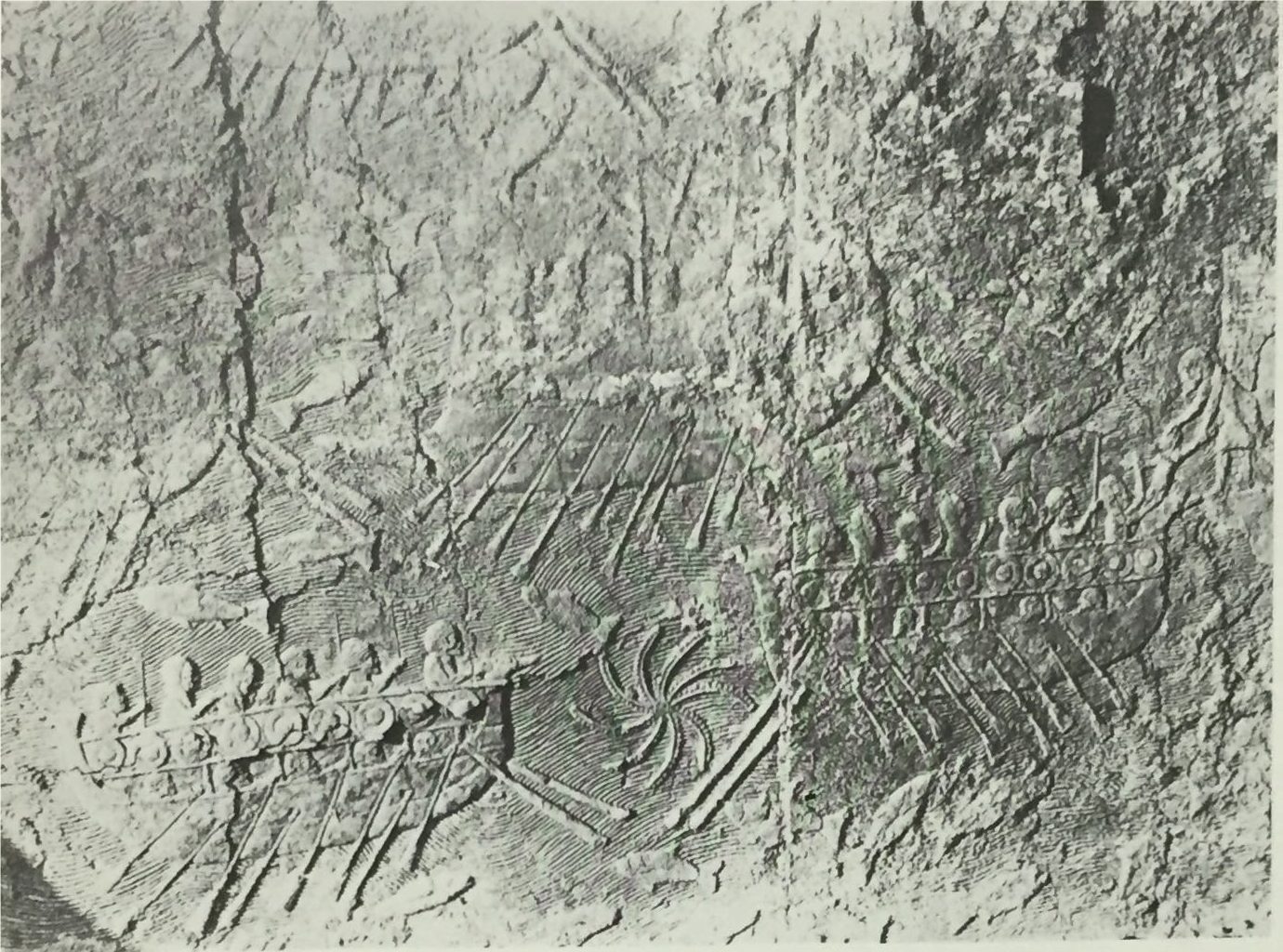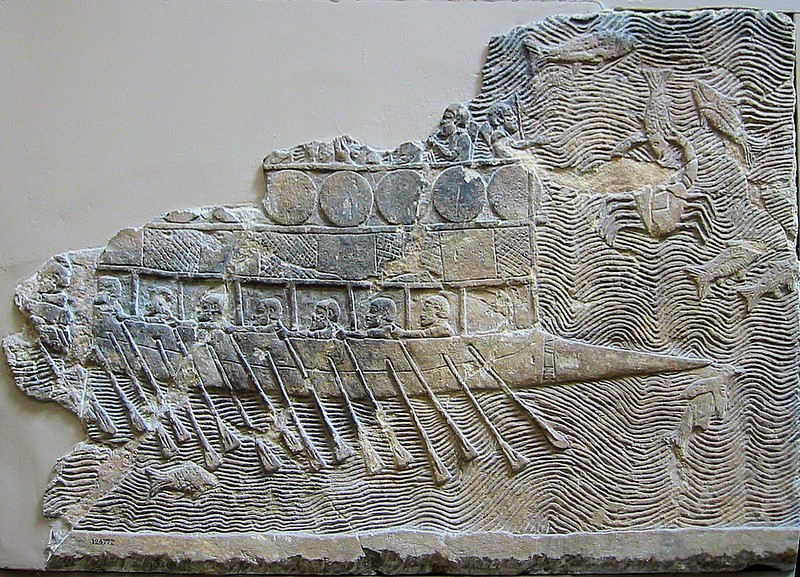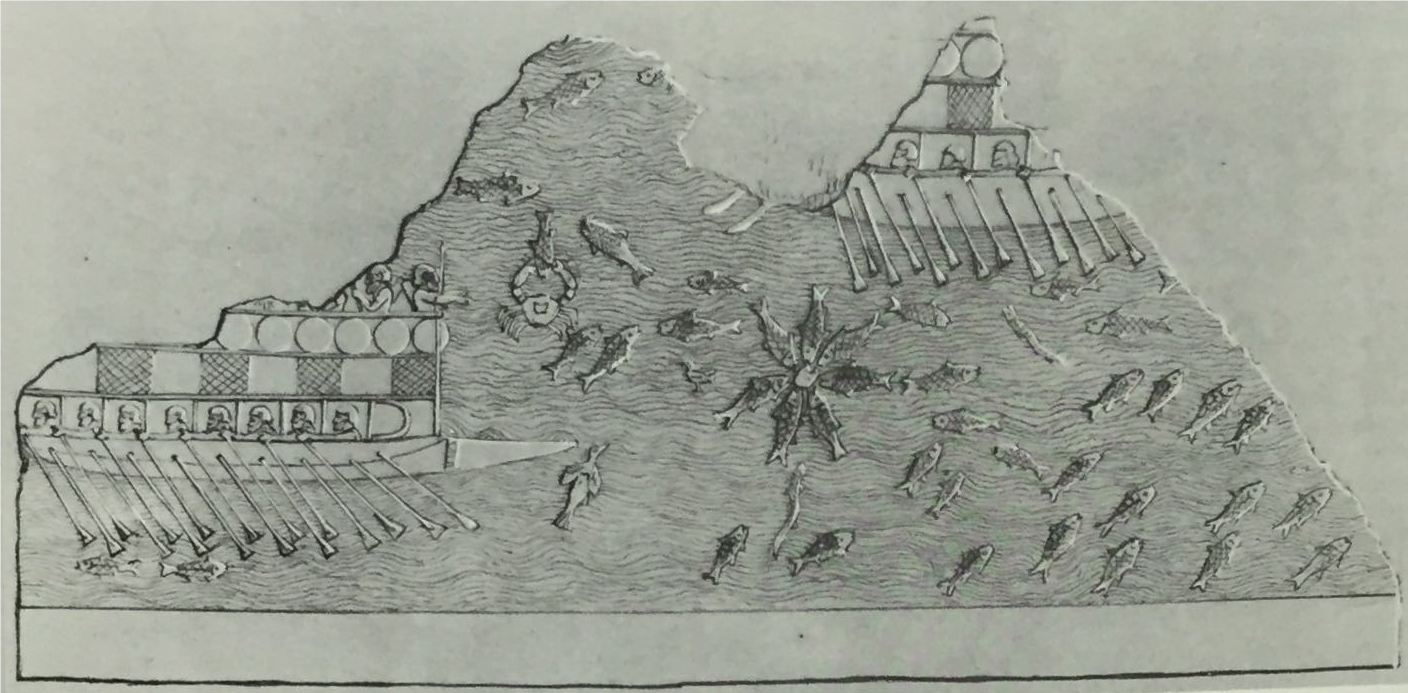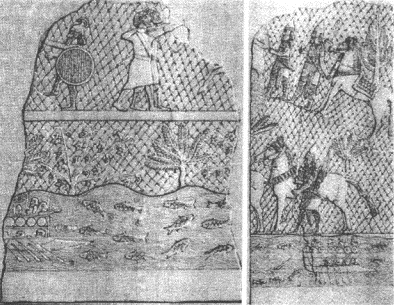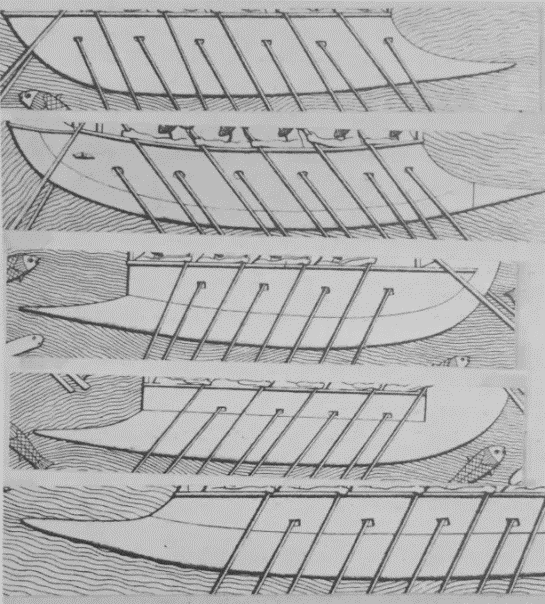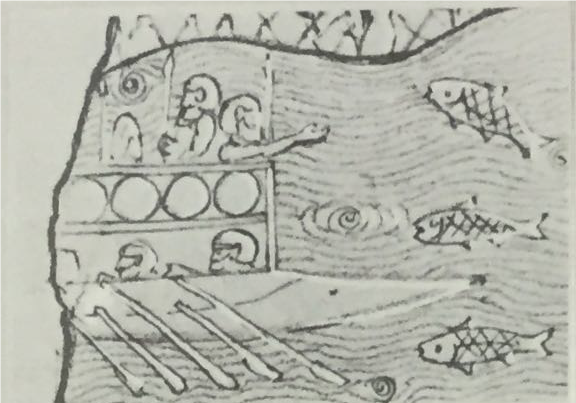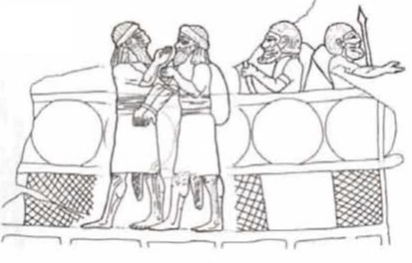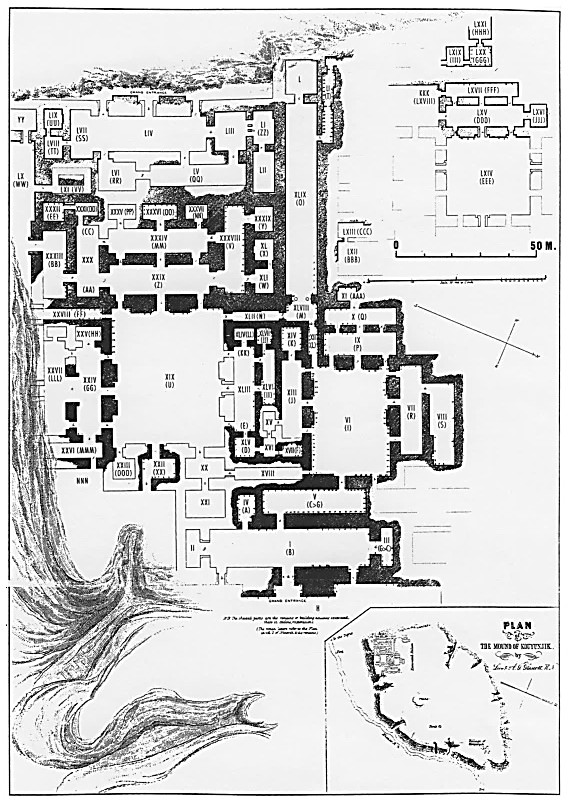Two distinct types of ships are depicted - a
war galley with a ram and vertical stempost (L31a), and a round ship
with a symmetrical hull and no bow projection (L31b). The two types
nonetheless have some fundamental commonalities, notably that both have
two levels of vertically staggered oars, with the upper level pivoted at
sheer level, while the lower level is operated through oarports. Both
ships furthermore have a third level above the rowers where passengers
and/or armed men stand on a deck, partially hidden behind a bulwark on
which shields are hung. Besides the obvious divergences in hull
morphology, there are three immediately visible differences between the
two types: 1) the presence of a ram on L31a; 2) the presence of a mast
and rigging on L31a which is absent on all of the round vessels; and 3)
the presence of an additional bulwark on L31a comprised of alternating
crosshatched and plain panels between the upper level of rowers and the
topmost bulwark with the shields. Despite this difference, the portion
of the passengers' bodies which appears above the uppermost bulwark
appears to be the same on all ships.
Type 1 (L31a): Flat hull with a vertical stempost and a high
incurving sternpost. The bow projection extends in a straight
continuation of the keel line. While it curves slightly upwards on some
of the ships, the BM vessel shows this lowest horizontal of the ship to
be very flat, with only a light curve towards the stern. Immediately
past the stempost, two parallel vertical lines demarcate the base of the
bow projection from the hull. Comparison with the Til Tarsip ship
confirms that this is meant to indicate metal sheathing. These two
parallel vertical lines are connected by two groups of three
perpendicular strokes, which indicate the means by which the sheathing
was attached. The stempost has no decorative device, while the sternpost
tapers into an incurving tip resembling a horn. Each ship has five
horizontal sections if we count the division midway on the hull created
by line x, which will be discussed last. The lower level of oars passes
through oar-ports in the hull, situated midway of section XA. Line A
represents the sheer, from which the upper level oars are operated.
Section AB is an open rower's gallery, with the oarsmen visible from the
shoulders up, their arm resting on the sheer. In the BM vessel, this
section has vertical stanchions dividing the individual "rooms" - a
pattern that is also repeated for the round vessels. In the engraving
from Room I however, these stanchions are missing (see remarks). In the
first room abutting the stempost on the BM ship the space is occupied by
a forecastle. Its edge is not straight as on Aegean geometric ships but
incurving, represented by a double semicircular line. Immediately above
the open rower's gallery is a bulwark (section BC) comprised of square
panels that alternate between solid and crosshatched screens. This
distinction indicates two different surfaces, perhaps comprised of
different materials or simply solid versus hatched wooden panels. In
either case the measure was likely designed to reduce weight. This
section is specific to this type and it is absent from the ships without
a bow projection (L31b). Section CD is an upper bulwark on which shields
are suspended for protection. It is a feature common to both types of
vessels. On the BM vessel, line C protrudes slightly beyond the stempost
and clearly acted as a wale for added rigidity, as was the case for line
B. Each ship is equipped with two steering oars, with the majority shown
being operated from the level of the open rower's gallery. The mast is
amidships secured by a fore and a backstay, with ships 3 and 5 having a
second, additional forestay. The yard is represented by a straight
horizontal line that does not reach more than half way on each side,
with the furled sails held by braces and sheets. Contrary to Aegean
representations, these latter are attached at the base of the mast.
The points which pose the most interpretative difficulties in increasing
order of magnitude are: 1) the function of the stanchions in section AB
which are absent from the war galleys of Room 1; 2) the additional lower
bulwark (section BC) not present on the round vessels; and 3) line X on
the hull.
1) As argued above, based on the more detailed vessels whose details can
be confirmed from the originals, the presence of the stanchions on all
vessels should not be doubted. These should be furthermore read *behind*
the rower's arms as seen on the BM ship, and thus indicate that they
functioned as support for the deck.
2) The additional lower bulwark with alternating panels is a distinct
characteristic of the war galleys. This feature makes the ships seem
dangerously high above the water. As a solution, Basch suggests that
these screens were meant to protect the rowers at their stations but
were conveniently represented above them. This hypothesis should be
rejected. It is true that one of the drawings from Room VIII shows a
warship where the lower bulwark has been omitted. This is however the
only instance, so it makes a lot more sense to frame it as the outlier
rather than the solution to the problem. The distinction between the two
types of ships based on this detail is very clear on the remainder of
the ships, including on both originals (BM relief and photograph from
Room I). It is thus best to treat this lone divergence as the "mistake"
- although it remains unclear whether it was committed in the original
relief or in the drawing only. Basch argues that the natural extension
of the bodies of the figures on the surviving ship from the British
Museum would result in their feet standing at the base of the upper
bulwark. This is clearly incorrect. If we compare the body proportions
of other figures from reliefs in nearby rooms, it becomes clear that the
part visible on the ships represents 1/3 of the total body. Sleeswyk
illustrates this point by taking Aramaic prisoners of war from Slab 10
in Room XXVIII and superimposing them on the ship's upper
structure (Sleeswyk 1999: 384, fig. 3). Applying the correct ratio on the war galleys results in
the figures standing at the base of the lower bulwark. Their feet would
thus have stood on a deck immediately above the heads of the second
level oarsmen. Even allowing for some latitude in the relative scale
between sculptures, the difference is too significant to accommodate
Basch's suggestion. It can be concluded that the lower bulwark is a key
feature of the war galleys that is represented in its actual position.
It appears that its function was therefore to provide protection for the
warriors fighting at deck level.
3) The thin horizontal line x on the side below the sheer clearly
indicates that there was a sharp break or change in the slope of the
hull at this point, which presents the question whether or not this is
an outrigger. Of the more recent interpretations, Basch offers a
reconstruction without an outrigger, with the ships requiring to be both
bigger and broader in order to accommodate the two levels of rowers.
Casson likewise reads the ships as having no outrigger, but reconstructs
a vessel that is wide and beamy amidships yet narrow at the waterline.
Sleeswyk finally identifies three different types of ships, one with an
"inrigger" and two different types of outriggers that alter the position
of the rowers. His interpretation however relies heavily on a very close
reading of the number of rowers on each level, as if their number and
positioning was exact. Once it is admitted that the artist was very
liberal with the number of rowers and that these are therefore
unreliable in identifying any real structural pattern, his entire
interpretation collapses. Likewise his reading relies on the differences
of representation of line x, whereas once more this appears to be
inconsistency on the part of the artist. This latter variation in the
rendition of line x poses a major obstacle in offering a sound
interpretation.
Type 2 (L31b): Crescent shaped hull with high vertical symmetrical
posts. The original photograph indicates that the stempost was decorated
with a naturalistic duck head device. The sternpost terminates in a
vertical device that flares out into a shape that resembles an inverted
triangle, capped by a straight horizontal edge. This form is identical
to the ship devices on the Sargon II reliefs, as well as the
Syro-Palestinian merchant vessels of the LBA. Each ship has four
horizontal sections if we count the division midway on the hull created
by line x. These are identical to those of the war galley except for the
lower bulwark (section BC) which is missing. The lower level oars pass
through oar-ports in the hull, situated midway of section XA. Line A
represents the sheer, from which the upper level oars are operated.
Section AB is an open rower's gallery, with the oarsmen visible from the
shoulders up, their arm resting on the sheer. This section has vertical
stanchions dividing the individual "rooms" on the majority of the ships.
Section BC is a bulwark on which shields are suspended for protection.
Both lines B and C extend to the posts, indicating that they are wales
that provided additional rigidity. Each ship is equipped with two
steering oars, with the majority shown being operated from the level of
the open rower's gallery. There is no mast. This vessel should still be
interpreted as a galley, not a round hulled merchant ship as most of the
scholarship erroneously argues. A double-levelled oared ship makes
absolutely no sense for cargo. The main difference is that this vessel
was not equipped with a bow projection, which poses no problems given
that the LBA galleys sporting a bird-headed figurehead don't have one
either. The 'tubby' impression of these vessels is an artistic
distortion which also affects Type 1.
Flight of king Luli
L31a-b
705-681 B.C.
Palace of Sennacherib at Nineveh (Kuyundjik)
H: 66.04 cm; W: 100.33 cm
Gypsum wall-panel reliefs
Albenda 1980: 227-28; Aruz et al 2014: 4-5; Ball 1899: 196; Barnett 1956: 91, 93, fig. 9; Barnett and Lorenzini 1975: pl. 66; Barnett et al 1998: 195b; Basch 1969: 144-152, fig. 11, pl. 6; 1987: 311-18, nos. 654-671; Birch 1883: 48-49, no. 2; Budge 1914: pl. 40; Casson 1995: 56-58, figs. 75, 76, 78; Casson and Linder 1991: 67, 69, fig. 5.2; De Graeve 1981: 68, pl. XLII, no. 88a; De Vries and Katzev 1972: 48; Fawcett 1994: 84, 93, fig. 11; Gadd 1936: 163, 226; Hall 1928: pl. XXXIII:1; Jacoby 1991: 119-21, fig. 9; Köster 1923: 52-53, no. 17; Layard 1849: pl. 71 ; 1853: 229; Lorenzini et al 1980: 78, no. 28; Mark 2008: 253, 257-259, figs. 5-6; Mauro 2019: 20-21, fig. 2.16; McGrail 2001: 132-133, fig. 4.30; Meissner 1920: vol. 1, abb. 120; Morrison and Coates 1996: 179-182, figs. Ia-b; Paterson 1915: 4, pl. 11; Pritchard 1969: 31, 253, fig. 106; Rankov 2017: 4, 13; Reade 1983: 40, fig. 57; Sleeswyk 1999: 383-92, figs. 1-9; Smith 1938: 16, pl. XL; Smith 2012: 80-82, fig. 5-1, 5-2; Torr 1964 64; Trakadas 1999: 73-81, figs. 29-31; Tubb 2018: 127, no. 135; Williams 1949: 127.
Reliefs with maritime scenes were found in two rooms of Sennacherib's south-west palace at Nineveh. Both compositions lack epigraphs, so that their narratives cannot be confirmed with absolute certainty. The composition from Room I on two contiguous slabs is now lost but has been reconstructed by Barnett from Layard's drawings (including some of unpublished ones). Thanks to a photograph which covers a part of this document, the fidelity of Layard's reproduction can be verified. A partial fragment from Room VIII is the only extant piece - now in the British Museum. It is complemented by another drawing which shows another ship to its right. In addition, Layard mentions similar seascapes in Rooms XXIV, XXXIV and XLI of which no record remains. Sennacherib's prolonged campaign to the land of Hatti (Syria-Palestine) was the subject of several groups of wall reliefs, with each room apparently describing a single military event where the main phases of action were presented in a unified whole. Albenda has argued that a change is observable in the composition of narrative scenes from the bas-reliefs over time. In the 9th century, events are described in a general manner, while "by the end of the 8th century B.C. this mode of representation was transformed into detailed, panoramic views that extended over large areas of wall surface. This later art yields an abundance of information concerning architecture, topography, military tactics, and foreign peoples."(Albenda 1980: 224).
Room I: The maritime scene of Room I - likely executed immediately after the third campaign - is widely thought to represent the escape of the Phoenician king Luli from Tyre in 701 B.C.: "in my third campaign I went against the Hittite land. Luli, king of Sidon, - my terrifying splendour overcame him, and from Tyre he fled to Iadnana [Cyprus] in the midst of the sea, and died." This identification is supported not only by the narrative of the composition itself, but also by the relief's location in Room I which is decorated with scenes of Sennacherib's western campaign (Jacoby 1991: 120). On the right of the scene is the city of Tyre, represented as a superposition of buildings according to Assyrian convention in order to show the city behind the fortifications. One of the buildings inside the city is depicted with an arched gate flanked by two columns with volute capitals (proto-ionic). The main action consists of a man in the process of handing a small child to a woman already aboard a ship. The scene is evidently situated inside a harbour, since the ship is already afloat, while the man stands on a platform in front of an arched gateway. The harbour is thus outside of the city's fortifications and was accessed by a postern. To the left of the fortified island is a flotilla of eleven ships comprised of two distinct types. Both types are double-levelled, but one is round hulled (6 ships), while the other is a war gallery equipped with a ram (5 ships). Nine of the vessels are fully packed with passengers (including women) and face left, presumably towards Cyprus. Two of the war galleys face right and have fewer figures on deck which are all men, suggesting that they are possibly defending the rear of the fleet. The background consists of a lush marine environment, including fish, turtles, sea snakes, lizards, crabs, and octopi.
Room VIII: scene comprised of three fragments thought to be contiguous, with Assyrian foot soldiers in the upper right. The rest of the fragment shows a body of water in which four galleys move to the right. The two directly below the Assyrian soldiers are on a much smaller scale. While similar in style to the ships in Room I, these vessels have a greater number of rowers - eight and nine for the upper and lower levels respectively in the extant British Museum fragment.
Reliability of reproductions: Comparing the photograph from Room I with the engravings shows several divergences, some of which are more minor than others:
1) The inner circle of the shields is much larger in the original.
2) The nine-armed octopus between ships E and F was given only 8 tentacles in the engraving.
3) the arrangement of the oars of ship E are much more disorderly in the original, whereas in the engraving they are neatly drawn strictly parallel to each other
4) Ship E has only eight oars, whereas the engraving has added a ninth. The lower level of oars are staggered, one between two of the upper ones, yet in the original the artist has omitted the lower oar between the second and third visible rower from the right. This negligence was "corrected" in the engraving.
5) The stempost device of ships E and F is a realistic duck head, while on the engraving they are shown with the flaring end typical of the ships of the Sargon II relief and of the LBA depictions of Syro-Canaanite merchant vessels. The device of ship E in particular is obvious in the photograph, with the eye and beak of the duck showing very clearly.
Looking at these discrepancies it appears that the majority of them were motivated by a rational rectification of sorts, where the engraver corrected what he perceived as a "mistake" by the Assyrian artist. This is the case for the number of octopus tentacles (2), and the addition of a ninth oar (4) on ship E which is otherwise consistent with the arrangement of the oars in the original relief. The slight discrepancy of the shields (1) and the more orderly reproduction of the oars (3) are likewise of little consequence in terms of the technical features of the ship. The only major alteration is thus the different prow device, which is of course of great significance. This latter discrepancy does not stem from a correction but rather a misunderstanding by the engraver. This limited comparison between the original and its reproduction indicates that there are definitely a number of divergences, although the majority of them do not affect the reconstruction of the vessels from a technical perspective. Basch concludes that the drawings can therefore be deemed as reliable overall, although any further discrepancies which might have been identified from further photographs will forever remain unknown.
Reliability of originals: in addition to the problem of discrepancies between the originals and Layard's reproductions, there are a number of details and peculiarities which can be plausibly attributed to the original compositions. These are indicative of the priorities of the Assyrian artist (s) and provide some opportunity to gage the overall concern with accuracy from a technical point of view:
1) Ship E has an oar missing on the lower level, between the second and third oars of the second level. This was clearly an unintentional omission since everywhere else the oars are staggered, with the lower oars centered between two oars of the upper level. It is precisely this otherwise consistent pattern which led the engraver to "correct" the ship by adding a fourth oar on the lower level of ship E.
2) The number of shields on the upper bulwark (8-10), number of passengers (5-7), and number of oars on each level (lower: 4-6; upper: 4-5) all vary from one vessel to another. There is, furthermore, no discernible pattern between the two types of ships, which indicates that the variability is completely random, albeit limited to a certain range which is understandable given that the vessels are of roughly similar proportions.
3) The steering oars are sometime at sheer level (A, E, 1 ?) and sometimes at deck level (B,C,D, 2,3,5). Once again there is no pattern depending on the vessel type. Basch thinks that the latter is more likely.
4) One of the war galleys in Room VIII shows that the lower bulwark has been omitted. As with the missing oar, this is clearly the outlier, as all other ships of this type have this second bulwark with alternating panels. It cannot be entirely ruled out that the omission has occurred during the reproduction rather than the original, although that is less likely.
5) The BM ship has vertical stanchions dividing the open rower's gallery similar to the round ships in Room I. The war galleys of Room I however appear to lack these. Quite a few of the ships from Room 1 have no stanchions within the open rower's gallery (1-5, A,C, D), an absence which is observed for both war galleys and round hulled ships. The two well preserved ships E and F on the photograph clearly show that these were present on at least some of the ships. These are again present in the BM ship, and apparently on the vessel to its left as preserved in Layard's drawing. Since all of the verifiable originals have these, and since the ships in Room VIII are overall executed with greater detail, it can be concluded that these are a structural feature of all the ships, despite its apparent omission on some vessels.
6) Only two ships (BM ship and the one second from the right in Room VIII) show a vertical detail at the base of the ram to denote the beginning of its metal sheathing. The BM ship is the most detailed of the two, showing also the horizontal fasteners that joined the two parallel verticals.
7) The BM ship has a forecastle occupying the first room of the open rower's gallery closest to the stempost. This detail is reproduced in Layard's drawing so that it appears that it was simply not present on the ships of Room I.
8) The ships in Room VIII are much longer, with the BM ship having nine and eight rowers on the lower and upper levels respectively. This was probably possible due to the fact that the scene is a lot less cluttered.
9) The arms of the oarsmen resting on the caprail of the second level are not depicted in a consistent manner vis à vis the stanchions when these are present. On ships E and F on the original photograph these do not overlap as the oarsmen's fists end right before the vertical lines. On the BM ship on the other hand the arms are very clearly in front of the stanchions. This also appears to be true for ship D and possibly slightly for ship E. Finally Basch argues that on ship B they are depicted behind the stanchions. This latter reading however is not unambiguous and derives only from the reproduction. It is quite possible that on the BM ship the overlap was caused by the fact that more rowers are depicted, thus slightly squeezing the space provided for each rower's room. This in turn forced the artist to show that the stanchions were on the inside of the rower's arm and thus the sheer, whereas in Room I this is not so clear because each "room" was lengthier. Since there is only one shaky potential example of the stanchion overlapping on top of the arm, the version from the BM original is to be preferred.
10) The horizontal line (x) dividing the hull midway which appears to indicate a sharp break in the slope of the hull's side is not depicted in the same manner on all ships. This line curves towards the posts on the ships from Room VIII as well as on six of the ships from Room I (C, D, E, F, 1, 5), is straight on ship 2, and completely absent on three ships (A,B, 3). Since the majority curve on both ends, including all of the verifiable originals, this variant is to be preferred.
11) On the round hulled vessels E and F, the naturalistic duck headed device caps the right hand post. On ship F this is a prow decoration, since the steering oars are on the left, yet on ship E the steering oars are on the right which means that the duck head decorates the sternpost instead. The most plausible interpretation is that ship F represents the correct version, and that the artist simply didn't realize that he had flipped directions for ship E - an easy miss considering that the posts are otherwise symmetrical.
The variations from one vessel to another makes it clear that the Assyrian artist (s) was not overly concerned with an accurate and consistent depiction of the number of rowers, since in reality the ships would have been much longer. His primary aim was to produce a harmonious and unified composition that was able to convey the event. This becomes all the more evident when the ships are compared to those of Room VIII, where a much less cluttered composition has allowed the artist to make his vessels nearly twice as long. An attempt at greater realism was therefore not wholly neglected - it was simply lower down on the priority scale compared to the scene's narrative. It is also possible that the ships in Room VIII were executed by a different hand, which could alternatively explain its more realistic proportions and greater level of detail. It may be added in support of this theory that the shields on the vessels in Room VIII are slightly different, having no inner circle. The BM ship's greater attention to detail can be summarized as follows: the depiction of the forecastle, the demarcation of the ram's bronze sheathing, the addition of stanchions to the open rower's gallery, and the greater number of oars. Some of the variability between vessels however creates much more room for disagreement in interpretation, since unlike the number of rowers, they can significantly affect the technical reading of the vessel. This is true for the stanchions in the open rower's gallery and the rendition of the horizontal line running along the hull. These illustrate once more that the artist (s) in Room I was quite lax in terms of the consistent rendition of important structural details, and was either not aware or not overly concerned with the implications of these variations.
Despite some interpretative difficulties, there are certain
core features of the ships which can be ascertained with confidence.
Both types have two banks of oars that were staggered vertically. Aegean
geometric double-levelled ships suggest a top heavy craft, with the
lower level rowed from gunwale level, while the upper line of oarsmen
rowed at the level of the raised deck. The Phoenician vessels represent
a further improvement that allowed for a much more compact ship, where
the upper level is rowed from the gunwale itself, while the lower level
is operated through oarports in the hull. Despite being contemporary,
the Phoenician vessels thus represent a further, improved stage in
design that can be considered a proper, fully fledged dieres.
The
presence of passengers further confirms that the ships have a
longitudinal deck that was situated immediately above the second level
of rowers. There are disagreements however on whether or not this was a
central deck only or a full deck from sheer to sheer. The manner in
which the two levels of rowers were arranged is also a matter of debate,
depending on whether or not line x is interpreted as an outrigger.
Despite their different hulls and functions, the two types of vessels
are not fundamentally different in their rowing arrangement. Although
there are a number of inconsistencies from one vessel to another that
indicate that the Assyrian artists did not have technical accuracy as
their foremost priority, the vessels are nonetheless depicted in much
greater detail than previous Assyrian depictions of ships with the
exception of L32. That the Assyrians were intimately acquainted with
Phoenician ships during Sennacherib's reign is confirmed by his annals,
where during his 694 campaign to Elam, the king commissioned Phoenician
shipwrights to build ships at Til barsib and Nineveh for the Assyrian
army.
Albenda, P. 1980. “Syrian-Palestinian Cities on Stone,” The Biblical Archaeologist 43.4: 222-229.
Aruz, J., S.B. Graff and Y. Rakic (eds.). 2014. Assyria to Iberia at the Dawn of the Classical Age. New York: The Metropolitan Museum of Art.
Ball, C. J. 1899. Light from the east: Or the Witness of the Monuments. London: Eyre and Spottiswoode.
Barnett, R. D. 1956. “Phoenicia and the Ivory Trade,” Archaeology 9: 87-97.
Barnett, R. D., E. Bleibtreu, G. Turner. 1998. Sculptures from the Southwest Palace of Sennacherib at Nineveh. London: British Museum Press.
Barnett, R.D. and A. Lorenzini. 1975. Assyrian Sculptures in the British Museum. Toronto: McLelland & Stewart Ltd.
Basch, L. 1969. “Phoenician Oared Ships,” MM 55: 139-162, 227-245.
―――. 1987. Le musée imaginaire de la marine antique. Athens: Institut Hellénique pour la preservation de la tradition nautique.
Birch, S. 1883. Assyrian Antiquities: Guide to the Kouyunjik Gallery (1883). London: British Museum Press.
Budge, E.A.W. 1914. Assyrian Sculptures in the British Museum, Reign of Ashur-nasir-pal, 885-890 B.C. London: British Museum Press.
Casson L. and Linder E. 1991. “The evolution in shape of the ancient ram,” in L. Casson and J. R. Steffy (eds.) The Athlit Ram. College Station, TX: Texas A&M University Press, pp. 6–39.
Casson, L. 1995. Ships and Seamanship in the Ancient World. Baltimore: Johns Hopkins University Press.
De Graeve, Chr. 1981. The Ships of the Ancient Near East (c. 2000-500 BC). Orientalia Lovaniensia Analecta 7. Leuven: Peeters.
De Vries, K. and M. L. Katzev. 1972. "Greek, Etruscan and Phoenician Ships and Shipping," in G. F. Bass (ed.) A History of Seafaring. New York: Walker, pp. 37–64.
Fawcett, N. 1994. “The Introduction of the Ram as a Weapon in Ancient Sea Warfare,” Akroterion 39 : 83-95.
Gadd, C. J. 1936. The Stones of Assyria: the surviving remains of Assyrian Sculpture, theior recovery, and their original positions. London: Chatto and Windus.
Hall, H.R. 1928. Babylonian and Assyrian Sculpture in the British Museum. London: British Museum.
Jacoby, R. 1991. “The Representation and Identification of Cities on Assyrian Reliefs,” IEJ 41.1/3: 112-131.
Köster, A. 1923. Das antike Seewesen. Berlin: Schoetz & Parr-hysius.
Layard, A H. 1849. Nineveh and its Remains. London: John Murray.
―――. 1853. Discoveries in the ruins of Nineveh and Babylon, with travels in Armenia, Kurdistan and the desert. London: John Murray.
Lorenzini, A., A. de Maigret, and L. Fozzati. 1980. Gli Assiri – La scultura dal regno di Ashurnasirpal II. Al regno di Assurbanipal (883-631 BC. Rome: De Luca Art Editions.
Mark, S. 2008. “The Earliest Naval Ram,” IJNA 37.2: 253–272.
Mauro, C.M. 2019. Archaic and Classical Harbours of the Greek World: The Aegean and Eastern Ionian Contexts. Oxford: Archaeopress.
McGrail, S. 2001. Boats of the World: from the Stone Age to Medieval Times. Oxford: Oxford University Press.
Meissner, B. 1920. Babylonien und Assyrien. Heidelberg: Winter.
Morrison, J. S. and J. F. Coates. 1996. Greek and Roman oared Warships. Oxford: Oxbow.
Paterson, A. 1915. Assyrian Sculptures, palace of Sinacherib. The Hague: Nijhoff.
Pritchard, J. B. 1969. The Ancient Near East in Pictures Relating to the Old Testament. Princeton: Princeton University Press.
Rankov, B. 2017. “Ancient Naval Warfare, 700 BC – AD 600,” in M. Whitby and H. Sidebottom (eds.) The Encyclopedia of Ancient Battles. John Wiley & Sons.
Reade, J. E. 1983. Assyrian Sculpture. London: British Museum Press.
Sleeswyk, A. W. 1999. “The Oarage of the Phoenician Biremes,” in H.E. Tzalas (ed.) Tropis V: 5th International Symposium on Ship Construction in Antiquity. Nauplia, 26, 27, 28 August 1993. (Hellenic Institute for the Preservation of Nautical Tradition). Athens: Hellenic Institute for the Preservation of Nautical Tradition, pp. 383-392.
Smith, A. M. 2012. “Phoenician Ships: Types, Trends, Trade and treacherous Trade Routes.” MA thesis, University of South Africa.
Smith, S. 1938. Assyrian Sculptures in the British Museum: from Shalmaneser III to Sennacherib. London: British Museum Press.
Torr, C. 1894a. Ancient Ships. Chicago: Argonaut.
Trakadas, A. L. 1999. “Skills as Tribute: Phoenician Sailors and Shipwrights in the Service of Neo-Assyria.” MA dissertation, Texas A&M University, US.
Tubb, J.N. 2018. “The Levant and Assyria.” in G. Brereton (ed.) I am Ashurbanipal King of the World, King of Assyria. London: Trustees of the British Museum, pp. 118-137.
Williams, R. T. 1949. “Ships in Greek vase-painting,” Greece and Rome 54: 126–37.
